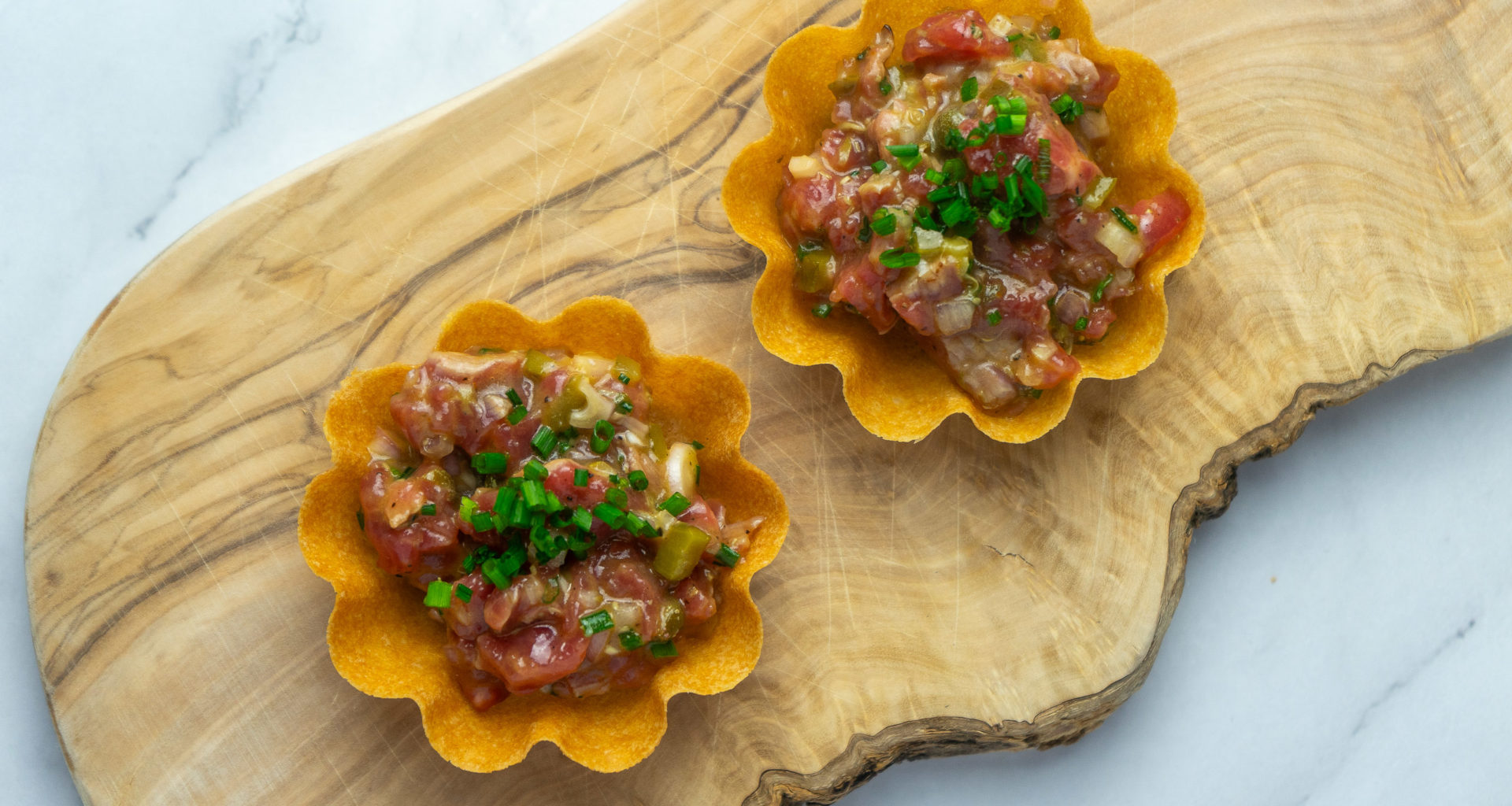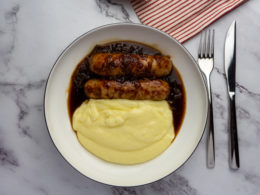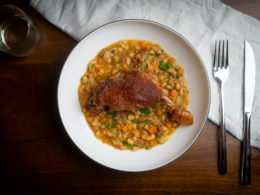A French classic, Beef Tartare is an easy yet impressive and tasty dish to prepare and is perfect for dinner parties. Served in restaurants all over France, it’s a popular dish that is surprisingly easy to make at home and uses a lot of store cupboard staples.
How to Make Beef Tartare
You’ll find beef tartare anywhere you go in France, from Paris Bistros to Saint Tropez beach clubs. Whatever the season, the French love it. The surprisingly light dish is packed with flavour and is very versatile. Raw beef is diced up by hand, seasoned liberally with shallots, capers, cornichon and egg yolk. Perfect with French fries for a main or slices of baguette for a starter, or as we did, in tartelettes as an elegant amuse-bouche.

What Beef to Use?
It’s important to pick the right cut of beef for a tartare – you can’t use any old piece. Firstly, it’s important to use prime cut. This means it should be from a cut that you would cook quickly and not use for stews. The best beef to use tend to be lean cuts such as beef fillet or onglet (which is my favourite). These are the best cuts to use for a tartare:
- Fillet mignon
- Sirloin/New York Strip
- Onglet/Hangar
- Bavette
- Ribeye
- Rump
Avoid using larger, tough pieces of beef such as Chuck, Cheek or Oxtail.
Finally make sure that the beef is fresh and inform your butcher that you’re planning on eating it raw. Beef tartare is very safe but it’s always good to make sure you get the freshest possible meat. Due to the fact that we’re using raw beef and raw egg yolks, it’s not advised to prepare this for those who are elderly, pregnant or for young children.
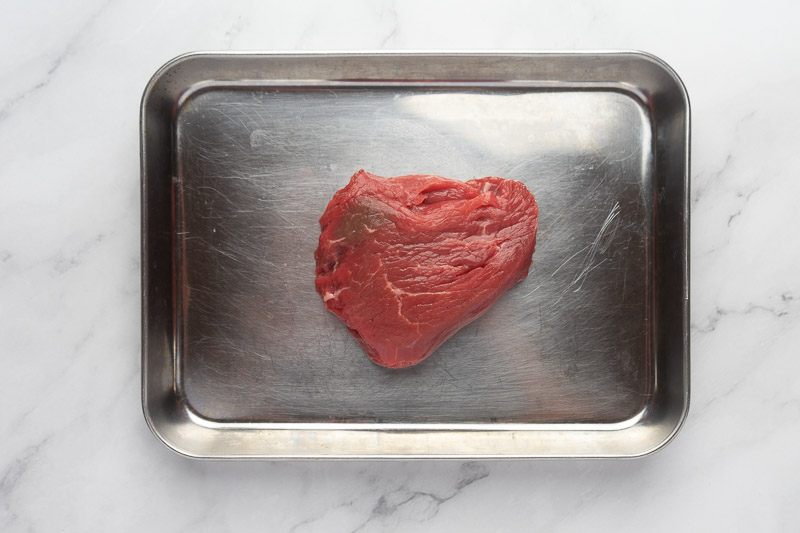
Classic Beef Tartare Ingredients
To make a classic French beef tartare, you’ll need:
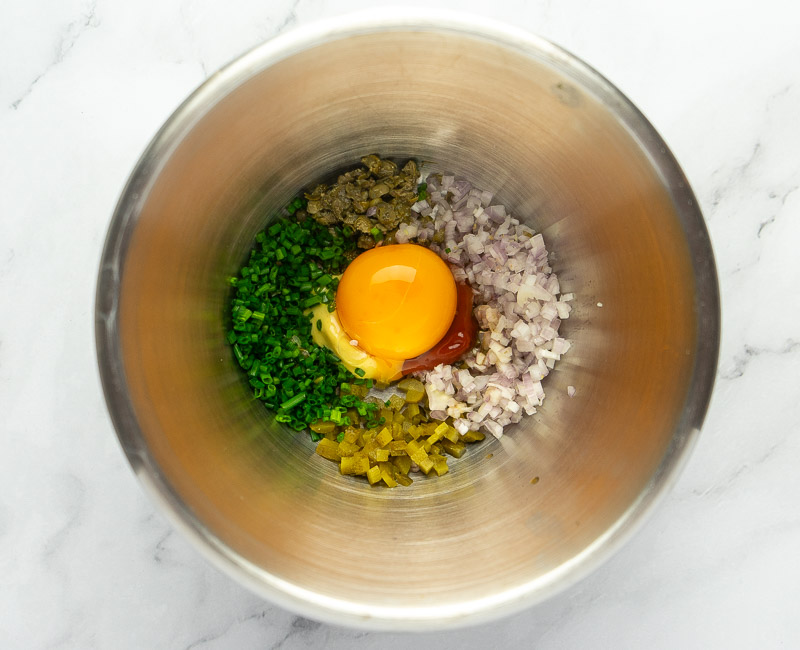
- Beef: A good lean cut of beef like fillet or onglet is the best for a tartare. Use fresh beef from a butcher and ensure it’s kept as cold as possible at all times.
- Cornichons: French cornichons are the best pickle element for a tartare (you can even use some of the small pearl onions in the jar too!). You can use dill pickles if you haven’t got cornichons but avoid using any sweet pickle.
- Capers: Capers in brine are key to the characteristic tartare flavour. Their slightly floral flavour and acidity backs up the cornichon wonderfully helping to break through the richness of the egg yolk and oil.
- Shallot: Onion and beef go hand in hand and a tartare is no exception. Finely minced shallot go so well in a tartare and should not be omitted. Shallot has a much milder flavour compared to a white onion. If you simply can’t find a shallot, soak thin slices of white onion in cold water to remove the harsh flavour before dicing.
- Mustard: For heat and some tang, Dijon mustard is the classic go to for a tartare. You can replace Dijon with wholegrain if you want to but avoid using sweet American mustard.
- Egg Yolk: A raw egg yolk is added for richness and to help bind the ingredients together.
- Worcestershire Sauce & Ketchup: Worcestershire sauce add umami to the tartare. You can omit if you haven’t got it or replace with a splash of tabasco. Ketchup adds colour and a bit of sweetness – again, you can omit this if you don’t like ketchup.
- Herbs: Chives or parsley work really well mixed through although any soft herb would work. Avoid using hard, woody herbs such as thyme or rosemary.

French Bistro Style Beef Tartare
A French classic, Beef Tartare is an easy yet impressive and tasty dish to prepare and is perfect for dinner parties. Served in restaurants all over France, it’s a popular dish that is surprisingly easy to make at home and uses a lot of store cupboard staples.
- Total Time: 20 minutes
- Yield: 2 portions 1x
Ingredients
- 200g beef fillet (or other prime-cut of your choice)
- 1 tbsp shallot, finely minced,
- 1 tsp capers, finely chopped
- 1 tsp cornichon, finely minced
- 1 egg yolk
- 1.5 tsp Dijon mustard
- 1 tbsp chives, finely chopped
- 1 tsp ketchup
- Splash of Worcestershire Sauce
- Splash of Extra Virgin Olive Oil
- Salt and Pepper, as required
Instructions
- Place a metal mixing bowl into the fridge 15 minutes before you prepare your tartare.
- Cut your fridge cold beef* into thin slices (1cm/0.25 inch thick). Slice each slice length-wise so you have one long rectangle of meat. Repeat for all slices.
- Line up all your strands of beef and chop into equal sized cubes. You don’t need to be super precise with this.
- Place the beef into the metal mixing bowl and reserve in the fridge.
- Chop up the rest of your ingredients and once complete, mix in with the cold beef.
- Add the sauces, egg yolk*, chives, olive oil to the bowl and mix to combine. You should have a sticky mix that’s well binded. Seasoned to taste with salt and pepper – you will need a fair amount as raw beef fillet doesn’t have that much flavour.
- Serve immediately and eat within 30 minutes. Serve with French fries and salad.
Notes
- If the beef is too tender, put it into the freezer for 15 minutes to firm up – this will make the slicing process much quicker.
- If you are worried about eating a raw egg yolk, you can confit them in the oven. Simply add them to a small oven-proof container and submerge in oil. Put them into a 100c/210f oven for 50 minutes to cook/pasturize.
- Optional Ingredients: A beef tartare is extremely customisable and you can adjust to your tastes. Classically, a tartare is finished with a raw or confit egg yolk. If you’re preparing it as a starter then try a quail egg. In the mood for a different style? Make it pan-Asian by adding spring onions, chilli, sesame seeds, nori and season with soy-sauce.
- Prep Time: 15 minutes
- Cook Time: 5 minutes
- Category: Entree
- Cuisine: French
What To Serve it With
In France it’s typically served as a main course with a side of hot French fries and a side salad drench in mustard hot vinaigrette.
If you’re wanting to serve it as a starter then thin slices of toasted baguette are perfect to add some crunch and act as ‘spoons’ to pick up the tartare.
Feeling fancy like we did for Christmas? Make a Brick/Filo pastry tartelette and serve it up as an elegant snack/amuse-bouche.
Is Beef Tartare Safe?
Beef tartare is generally very safe if the beef has been well handled and not been cross-contaminated. If you like rare beef then it’s very similar. Unlike chicken, beef can be eaten completely raw.
You can take certain measures to ensure safety when buying and handling raw beef:
- Inform your butcher that you’re eating raw beef and ask for the freshest cuts possible
- Fresh, raw beef shouldn’t smell – if you smell any off odour then put it in the bin
- Don’t serve this dish to pregnant women or the elderly
If yourself or your party are happy with very rare steak but have some concerns then you can do the following:
- Freeze the beef for 10 minutes then add to a ripping hot pan and if possible, sear with a blow torch to kill any bacteria on the outside. This can even add more flavour and the inside will be completely raw!
Who Invented It?
There’s no real understanding of where the dish as we know it originated from. Any meat that you can eat raw (lamb, duck, beef, veal) can be made into a tartare and therefore it’s very difficult to pin point.
Some theories point to the Tartar tribe originating from modern-day Turkey. It’s said that they placed meat on the horses and the saddles and became crushed as they rode. Another theory is that it came from French Polynesia in the early 1900s – a region where raw meat and fish was popular.






